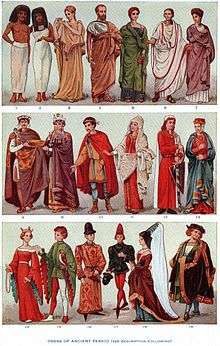Peascod belly
A peascod belly is a type of exaggeratedly padded stomach that was very popular in men's dress in the late 16th and early 17th centuries. The term is thought to have come from "peacock,"[1] or from the form of contemporary plate armour.[2] Sometimes it was called a 'goose belly.'[3]
 Archduke Ferdinand of Tyrol, 1542, by Jakob Seisenegger
Archduke Ferdinand of Tyrol, 1542, by Jakob Seisenegger Charles V Standing with His Dog, by Titian
Charles V Standing with His Dog, by Titian

Charles, Archduke of Austria, wearing a peascod bellied doublet in 1569
In the late 16th century the stomach of the doublet was padded to stick out,[4] however, by 1625, the padding had become more evenly distributed over the chest area.[5]
References
- Tortora, Phyllis G.; Eubank, Keith (2005). Survey of Historic Costume (4th ed.). New York: Fairchild. p. 175.
- François Boucher; Yvonne Deslandres (1987). 20,000 Years of Fashion: the history of costume and personal adornment (Expanded ed.). New York: Harry N. Abrams. p. 228. ISBN 0-8109-1693-2.
- Bradley, Carolyn G. (2001). Western world costume : an outline history (Dover ed.). Mineola, N.Y.: Dover Publications. p. 174. ISBN 9780486419862.
- Harvey, Sara M. (2008). "The Seventeenth Century". In Condra, Jill (ed.). The Greenwood encyclopedia of clothing through world history. Westport, Conn. [u.a.]: Greenwood Press. p. 125. ISBN 9780313336645.
- Harvey, Sara M. (2008). "The Northern Renaissance". In Condra, Jill (ed.). The Greenwood encyclopedia of clothing through world history. Westport, Conn. [u.a.]: Greenwood Press. p. 70. ISBN 9780313336645.
This article is issued from Wikipedia. The text is licensed under Creative Commons - Attribution - Sharealike. Additional terms may apply for the media files.
